Anti-tank SAU of Germany during the war (part 9) - Jagdtiger
Experimental design work on the creation of heavy SAUs have been conducted in Germany since the beginning of the 1940s, and even led to local successes. In the summer of 1942, two 128-mm ACS based on VK 3001 (H) were sent to the Eastern Front near Stalingrad. One of these vehicles was lost in battle, the other along with the remaining 521 technique of the tank fighter division was abandoned by the Wehrmacht after the defeat of the German fascist group near Stalingrad at the beginning of 1943.
At the same time, even the death of Paulus 6 army did not affect the launch of such SAUs in the series. In society and ruling circles, ideas prevailed that the war would end in victory for Germany. Only after the defeat at Kursk arc, in North Africa and the landing of the allies in Italy, many Germans, blinded by propaganda, realized the reality - the combined forces of the countries of the Anti-Hitler coalition many times exceeded the forces of Germany and Japan, only a “miracle” could save the dying German state.
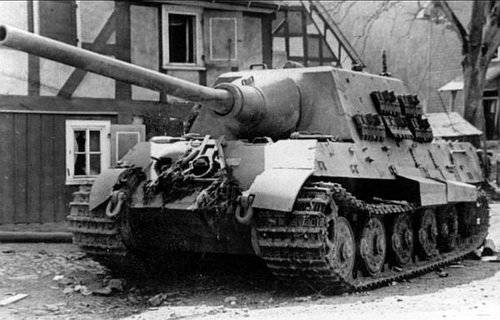
Then, conversations began about the “miracleweapons", Which can change the course of the whole war. Such rumors became officially German propaganda, which promised the people of Germany an early change in the situation on the fronts. At the same time, there were no sufficiently effective globally (nuclear weapons and their analogues) developments in the final stage of readiness in Germany. Therefore, the leadership of the Reich was forced to clutch at any significant military-technical projects that were capable of their originality and unusualness, along with defensive capabilities to carry out psychological functions, inspiring the people with thoughts about the strength and power of the state, which is capable of creating such sophisticated equipment. It was in such a situation that the heavy tank destroyer - self-propelled guns "Yagdtigr" was created and launched into a series. Jagdtiger became the heaviest model of serial armored vehicles produced during the Second World War.
The new ACS was classified as a 128-mm heavy assault gun. Its main weapon was to be the 128-mm PaK 44 gun, created on the basis of the Flak 40 anti-aircraft gun. The high-explosive ordnance of this gun had a higher explosive effect than that of a similar anti-aircraft gun. A wooden model of the future ACS was presented to Hitler 20 on October 1943, at the Aris training ground in East Prussia. The Jagdtigr SAU produced a favorable impression on the Führer, and he gave the order to begin its serial production in 1944.
Description of construction
The overall layout of the ACS Jagdtiger as a whole repeats the tank "Royal Tiger". At the same time, the load on the chassis increased when fired, so the chassis was extended by 260 mm. Branch self-propelled control was in front of the machine. Here were the main clutch, steering mechanism and gearbox. To her left were the controls, the dashboard, and the driver's seat. On the right, in the case, a course machine gun and a gunner-radio operator seat were installed. Here above the gearbox and the right-hand side transmission was a radio station.
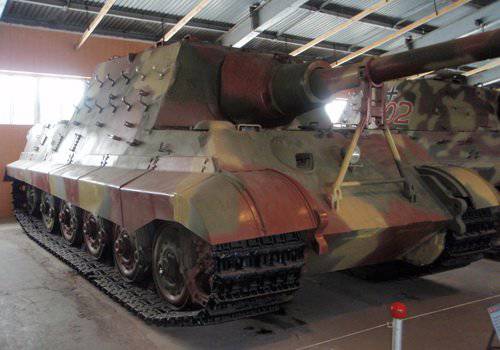
In the case of SAU "Yagdtigr" six types of plates with thickness from 40 to 150 mm were used. The upper front hull sheet had a thickness of 150 mm., Was solid and had only one embrasure to install a machine gun course. In the upper part of the front hull sheet, a special cut was made, which provided the driver with a better view of the car. In addition, in the front part of the hull roof there were landing hatches of the radio operator and driver.
The fighting compartment was located in the middle part of the ACS. There was an armored cabin with a tool. To the left of the gun there were pointing mechanisms, a periscope sight, and a gunner’s seat. The seat of the commander was located to the right of the gun. On the floor of the fighting compartment and on the walls of the cabin was located ammunition to the gun. In the back of the cabin there were places for two loaders.
In the engine compartment, located in the rear of the hull, there was a propulsion system, cooling radiators, fans, and fuel tanks. The engine compartment was separated from the battle bulkhead. On the “Yagditgre” the same engine was installed as on the PzKpfw VI “Tiger II” tank - 12 V-shaped cylinder (camber of 60 degrees) carburetor “Maybach” HL230Р30, which developed the maximum power in 700 hp at 3 000 rpm (in practice, the number of revolutions did not exceed 2 500).
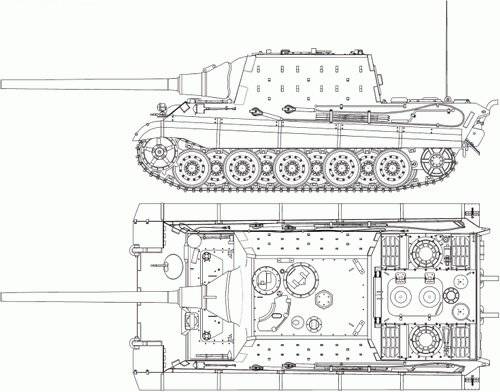
It should be noted that the armored corps SAU "Jagdtigr" practically did not change in terms of design, or in terms of booking. The deckhouses were one with the hull sides and had the same armor in 80 mm. The deckhouses had a slope of armor plates in 25 degrees. The frontal and stern sheets of the cabin were interconnected “into a spike”, additionally strengthened with dowels, after which they were scalded. The thickness of the frontal sheet of the cabin reached 250 mm., The frontal sheet of the cabin was located at an angle of 15 degrees. None of the anti-tank weapons of the allies could break a self-propelled head-on from a distance of more than 400 meters. Aft logging also had a thickness of 80 mm. In the stern cabin sheet there was a hatch for loading the ammunition, dismantling the gun and evacuating the crew, the hatch was closed with a special double flap hinged.
The roof of the cabin was made of 40-mm armor plates and was attached to the body with bolts. In front of the right there was a rotating commander's turret with a viewing device, which was covered by a U-shaped armor bracket. Before the turret in the roof of the cabin there was a flap for installing a stereo tube. Behind the commander's turret there was a manhole for the commander's landing / disembarking, and to his left was an embrasure of the periscope sight of the gun. In addition, a melee device, an 4 surveillance device and a fan were mounted here.
In the embrasure of the frontal cutting room, covered with a massive cast mask, mounted 128-mm gun StuK 44 (or Pak 80). The initial speed of the armor-piercing projectile of this gun was 920 m / s. The length of the gun was equal to 55 caliber and was (7 020 mm). Gross weight - 7 000 kg. The gun had a wedge, horizontal shutter, which was automated at. Opening the shutter and extracting the liner was carried out by the gunner, and after discharging the projectile and the charge, the shutter was closed automatically.
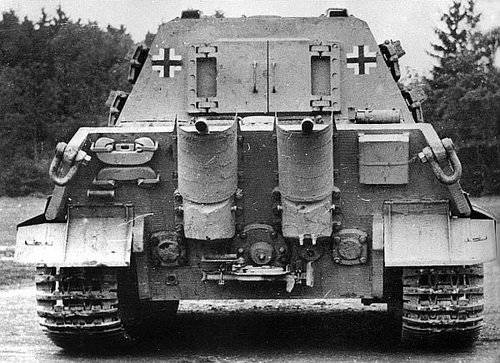
The gun was mounted on a special machine, which was installed in the body of self-propelled guns. The angles of vertical alignment ranged from -7 to + 15 degrees, horizontal - 10 degrees in each direction. Recoil devices were above the barrel of the gun. The maximum length of the rollback was 900 mm. The greatest range of high-explosive fragmentation projectiles was 12,5 km. The gun StuK 44 differed from its progenitor of the anti-aircraft gun Flak 40 by separate-sleeve loading. In a fairly close cabin, SAU with bulky unitary ammunition simply would not turn around. To speed up the loading process, the crew of the Jagdtiger ACS had 2 loaders. While one of them sent a shell to the guns, the second filed a cartridge case with a charge. Despite the presence of two guns charging the rate of fire was at the level of a shot per minute 2-3. Ammunition guns consisted of 40 shots.
The WZF 2 / 1 periscope sight, used on self-propelled guns, had an 10 magnification and field of view in 7 degrees, with the help of this sight it was possible to hit targets at a distance of 4 km.
Auxiliary armament "Yagdtigra" consisted of a course MG 34 machine gun, which was located in a special ball mounted in the front hull plate. Ammunition machine gun was 1 500 ammunition. In addition, a special 92-mm anti-personnel grenade launcher — a melee weapon — was installed on the cabin roof. On late-release machines, a special bracket for installing the MG 42 anti-aircraft machine gun was also installed on the cabin roof.
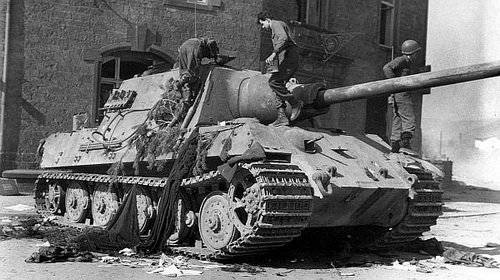
Epic with suspension
The assembly of the Jagdtiger self-propelled gun (like the Tiger II tank itself) was the most time-consuming operation, which significantly delayed the production process. That is why the design office of Ferdinand Porsche, in the order of private initiative, made a proposal to use the suspension on this ACS, similar to that used at the Ferdinand PT-ACS.
Its peculiarity was that the torsion bars were not inside the hull, but outside the inside of special carts. Each of these longitudinally located torsions serviced the 2 track rollers. The weight gain when using such a suspension was 2 680 kg. In addition, the installation and twisting of the torsion of the standard Henschel suspension was only possible in the assembled case, in strict sequence when using a special winch. Replacement balancers suspension and torsion bars could be performed only in the factory. The assembly of the Porsche suspension could be carried out separately from the case, and the installation was carried out without the use of special equipment. Repair and replacement of suspension units could be carried out in front-line conditions and did not present any particular difficulties.
In total, 7 machines (5 serial models and 2 prototypes) were manufactured with a Porsche design suspension, the first Jagdigr with a Porsche suspension was tested even earlier than the SAU with Henschel suspension. Nevertheless, in spite of all the advantages of the Porsche suspension, on the recommendation of the Arms Administration, another machine went into the series. The main reason was more than strained relations between the famous designer and the ministry officials, as well as the breakdown of one of the carts during the tests, which, by the way, was caused by the manufacturer’s company. It is also impossible to disregard the fact that the Armaments Directorate wanted to achieve maximum unification between the SAU and the Royal Tiger tank.
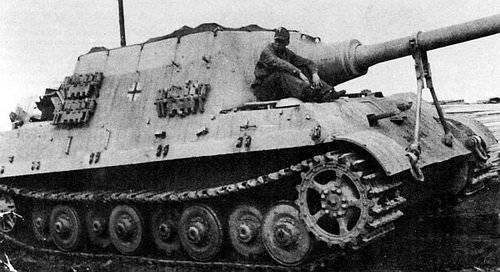
As a result, the chassis of the serial "Yagdtigra" consisted of 9 all-metal dual support rollers with internal depreciation (on each side). The rollers were staggered (5 in the outer row and 4 in the inner row). The dimensions of the rollers were 800x95 mm. Their suspension was individual torsion bar. The front and rear roller weights were equipped with hydraulic shock absorbers that were inside the case.
In total, from July to April 1945 of the year in Germany were collected from 70 to 79 similar self-propelled guns, therefore, about any of their mass use was not the question. Most often, SAU "Jagdtigr" engaged in combat platoon, or individually, becoming part of hastily formed fighting groups. The undercarriage was too congested, which resulted in low mobility and frequent breakdowns. For this reason, the design of the ACS provided for the installation of two stationary demolition charges. One was under the breech of the cannon, the second under the engine. Most of the SAU was destroyed by their own crews, if it was impossible to tow the car to the rear. The use of the Jagdigres was episodic, but any appearance of them in battle was a big headache for the allies. The gun mounted on the SAU made it possible to easily hit any Allied tank from the extreme distance in 2,5 km.
Performance characteristics: Jagdtiger
Mass: 75,2 t.
Dimensions:
Length 10,654 m., Width 3,625 m., Height 2,945 m.
Crew: 6 people.
Reservations: from 40 to 250 mm.
Armament: 128-mm gun StuK44 L / 55, 7,92-mm machine gun MG-34
Ammunition: 40 projectile, 1500 ammo.
Engine: 12-cylinder gasoline liquid-cooled engine "Maybach" HL HL230Р30, power 700 hp
Maximum speed: on the highway - 36 km / h, over rough terrain - 17 km / hour
Power reserve: on the highway - 170 km., Over rough terrain - 120 km.
Information